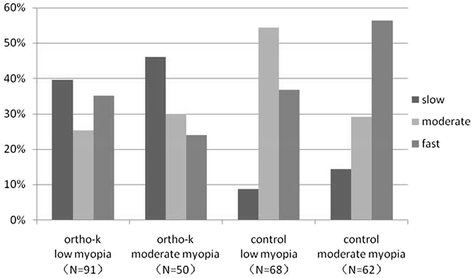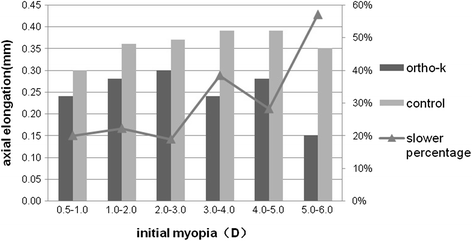Effects of orthokeratology on the progression of low to moderate myopia in Chinese children
- PMID: 27464993
- PMCID: PMC4964026
- DOI: 10.1186/s12886-016-0302-5
Effects of orthokeratology on the progression of low to moderate myopia in Chinese children
Abstract
Background: To investigate the effectiveness of orthokeratology (ortho-k) in reducing the development of myopia in Chinese children with low to moderate myopia.
Methods: This was a retrospective study. In the ortho-k group, there were141 subjects, and the average age was (9.43 ± 1.10) years. The average spherical equivalent refractive error (SER) was (-2.74 ± 1.15)D, with examinations performed 1, 7, 30, and 90 days and 12 months after the patients started wearing ortho-k lenses. In the control group, there were 130 subjects, and the average age was (9.37 ± 1.00) years. The average SER was (-2.88 ± 1.39)D, with examinations performed every 6 months. Axial elongation, which is an important parameter reflecting the progression of myopia, was measured at baseline from the same IOLMaster each time by the same masked examiner and was compared between the groups after 1 year. The subjects were divided into two sub-groups according to age to further study the development of myopia at different ages. An unpaired t-test, paired t-test, Chi-square test and Spearman test were performed to analyze the data.
Results: After 1 year, the average axial elongation was (0.27 ± 0.17) mm in the ortho-k lens group and (0.38 ± 0.13) mm in the control group, with a significant difference between the groups (P < 0.001). Axial elongation was not correlated with SER but had a negative correlation with initial age (ortho-k group: r s = -0.309, p < 0.01; control group: r s = -0.472, p < 0.01). The percentages of individuals with fast myopic progression (axial elongation > 0.36 mm per year) were 38.0 % among younger children (7.00 to 9.40 years) and 24.3 % among older children (9.40 to 12.00 years), whereas the respective percentages were 76.5 and 12.9 % in the control group. When SER ranged from -5.0D to -6.0D, the axial elongation in the ortho-k group was 57.1 % slower than that in the control group.
Conclusions: Ortho-k lenses are effective in controlling myopic progression in Chinese children, particularly in younger children and in children with higher myopia.
Keywords: Axial length; Chinese; Effectiveness; Myopia control; Orthokeratology.
Figures




References
MeSH terms
LinkOut - more resources
Full Text Sources
Other Literature Sources
Medical

